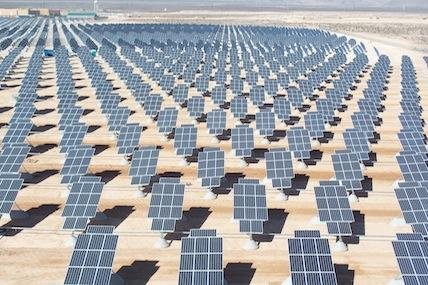The Air Force and Army are committed to developing 1 billion watts of renewable energy on their installations by 2025, senior leaders from both services announced May 23.
The plan marks the latest milestone in a multi-year endeavor to find ways to make the military more energy efficient, said Katherine Hammack, the assistant secretary of the Army for installations, energy and environment, and Terry Yonkers, the assistant secretary of the Air Force for installations, environment and logistics.
One gigawatt, a unit of power equal to 1 billion watts, can power about 250,000 homes, Hammack explained.
Energy security drives the initiatives, Hammack said, adding that increased usage of renewable energy -- such as solar power -- on military installations would enable them to operate even if local power grids go down.
"Right now, the bases operate off of a nationwide electric grid, which, as populations grow, is getting aged and vulnerable," Hammack said. "This is a move toward distributed energy where you're generating (it) at the point of use."
The Army Corps of Engineers will work with the two services to assess land and resources and to determine energy transmission capabilities, Hammack said.
As the technology develops, she said, renewable energy steps will include the installation of solar paneling on military base buildings and vehicle garages, and dual-usage of the panels as land buffers.
Biofuels will be a behind-the-scenes game changer for the Air Force, according to Yonkers, who lauded the seminal research of alternative fuels at Wright-Patterson Air Force Base, Ohio.
"These biofuels don't produce the kind of soot that conventional crude oil-derived fuels produce," Yonkers said, adding that this results in a cooler-running engine, which reduces metal fatigue and increases engine life.
"If you can reduce the temperature in the combustion chamber of an engine by as little as a hundred degrees, you can get 10,000 hours or more on those parts that compose that engine," Yonkers said.
As the United States continues to seek ways to reduce dependency on imported oil, biofuels could play a large part in the transition while reducing the cost to taxpayers, he said.
"Maintenance costs will go down substantially. We can keep those engines (online) much longer and the overall cost of doing business with the Air Force goes down," Yonkers said.
Private sector financing will be the linchpin of the services' energy endeavors through power purchase agreements, enhanced use leasing, energy savings performance contracts and utility energy savings contracts, Yonkers explained.
New sources of clean energy will vary among installations, he said, and will include solar, wind, biomass and geothermal developments.
The desired end result of these advances, Yonkers said, is to "reduce demand, increase supply and change the culture of how airmen and soldiers consider energy."
The Army will host the Army-Air Force Energy Forum July 12 in Arlington, Va.





























